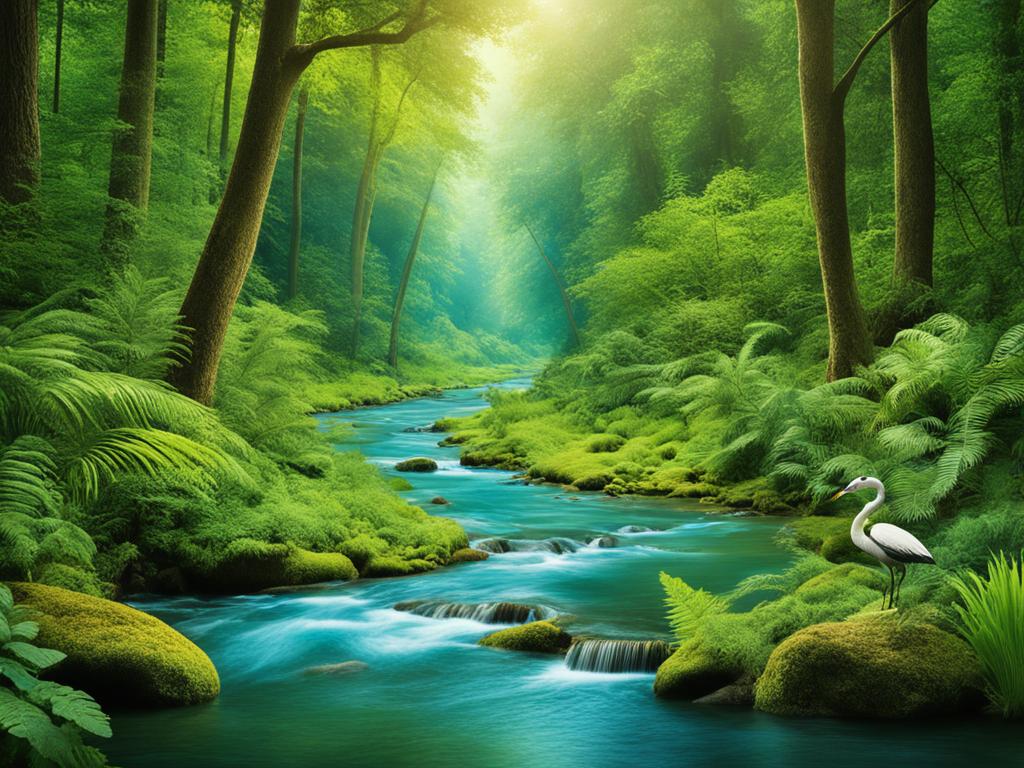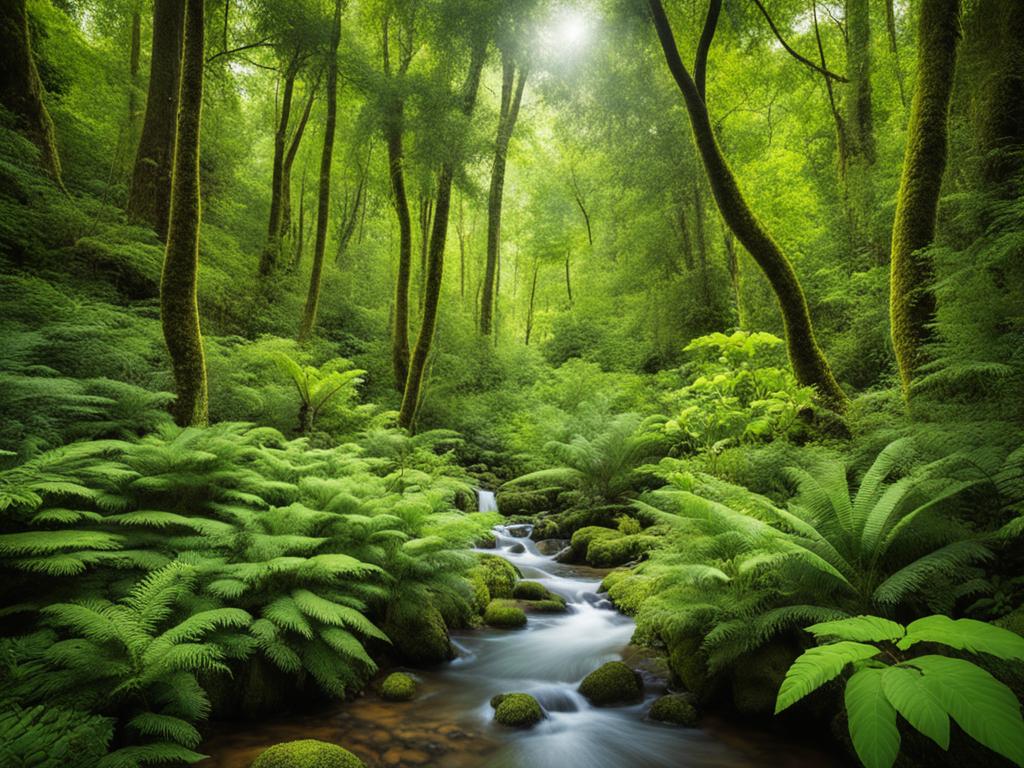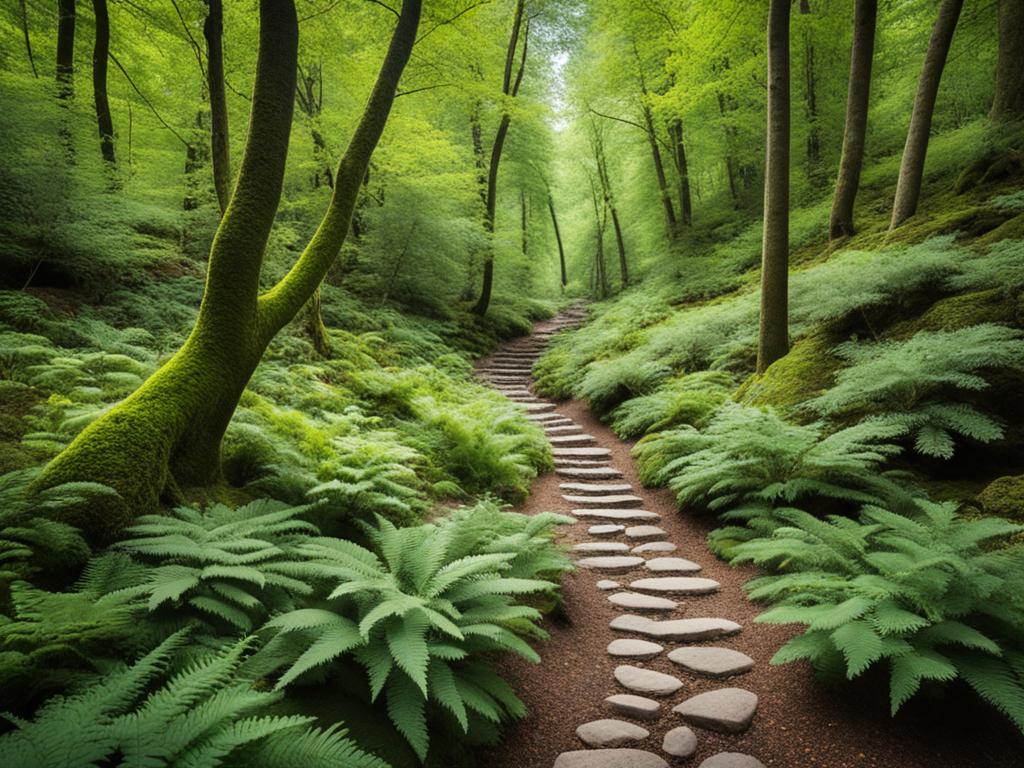Keeping wildlife habitats safe is crucial. It helps protect biodiversity and endangered species. It also keeps the ecological balance in check. In this article, we’ll look at why conserving wildlife habitats matters. We’ll also talk about how to do this and what challenges exist. We’ll cover the positives of habitat conservation, from ecological balance to economic benefits and enhancing human well-being. Plus, we’ll discuss threats like habitat loss, climate change, and invasive species.
We’ll dive into how conservation efforts have succeeded. This includes work in protected areas and community-based initiatives. We’ll see the importance of habitat restoration and rehabilitation. Also, the article will cover the species-area relationship. This is key for joining fragmented habitats using wildlife corridors and crossing structures. Lastly, we’ll give readers ways to help, like through volunteering and supporting conservation organizations.
Key Takeaways
- Safeguarding wildlife habitats is crucial for maintaining biodiversity and ecological balance.
- Habitat loss, climate change, and invasive species pose significant threats to wildlife habitats.
- Conservation efforts, such as protected areas, community-based initiatives, and habitat restoration, have been successful in preserving and restoring wildlife habitats.
- The species-area relationship and connecting fragmented habitats through wildlife corridors and crossing structures are important concepts in habitat conservation.
- Individuals can contribute to wildlife habitat conservation through volunteering, supporting conservation organizations, adopting sustainable practices, and raising awareness.
Understanding Habitat Conservation
Habitat conservation works to keep natural places safe for both animals and us. It means keeping special places safe to help plants and animals live there. This helps keep a variety of life forms around and stop them from disappearing.
Types of Habitats
There are different kinds of homes for nature, like forests, grasslands, and the oceans. Each one is important for keeping nature in balance. They help different plants and animals live well together.
The Role of Biodiversity
Biodiversity means the many kinds of life on Earth. Protecting where they live is key to keeping our planet healthy. It makes nature strong and able to survive changes.
| Habitat Type | Ecosystem Services | Key Wildlife Species |
|---|---|---|
| Forests | Carbon sequestration, air purification, water regulation | Orangutans, Siberian tigers, Quokkas |
| Grasslands | Nutrient cycling, soil conservation, forage for herbivores | Bison, Pronghorn, Wildebeest |
| Wetlands | Water purification, flood control, nursery for aquatic life | Whooping cranes, American alligators, Manatees |
| Deserts | Drought resistance, nutrient cycling, habitat for adapted species | Camels, Fennec foxes, Gila monsters |
| Marine Ecosystems | Coastal protection, fisheries production, carbon sequestration | Coral reefs, Sea turtles, Humpback whales |
Learning about different habitats and their roles can help us protect them better. This way, we can make sure lots of plant and animal kinds continue to thrive.
The Benefits of Conserving Wildlife Habitats
Preserving wildlife habitats brings many good things. This includes helping the environment, boosting the economy, and making people’s lives better. It ensures the environment’s health is good. Conservation supports essential activities such as pollination and climate control.
Economic Benefits
Healthy habitats are a big help economically. They allow for sustainable use of resources and fun activities like ecotourism. They also lessen the impact of natural disasters, thus saving a lot of money. For example, in North and South America, nature contributes about $24 trillion each year.
Enhancing Human Well-being and Quality of Life
Conserving nature also means happier people. It gives space for leisure, education, and wonder. Traveling to see wildlife has become more popular, bringing in $600 billion yearly. This shows how much we value nature’s contribution to our happiness and well-being.

Threats to Wildlife Habitats
Many things are putting wildlife habitats at risk, which harms our ecosystems and the wide variety of life on Earth. Habitat loss is a big issue, mostly because of human actions like farming, building cities, and taking resources. This causes places for animals to live and find food to get smaller and more spread out. Climate change also plays a big part, messing up natural processes and taking away resources many species need.
Habitat Loss and Fragmentation
When places where animals live disappear, it’s called habitat loss. This often happens because of people expanding farms, building cities, and taking natural resources. As these habitats shrink and become separate, it gets hard for animals to move between them. This means they can’t find food or live in healthy numbers.
Climate Change and Its Impact on Habitats
Climate change messes up wildlife habitats in many ways. It changes temperatures and how much it rains, throwing ecosystems out of balance. This leads to animals losing the food and shelter they depend on. Sea levels are also rising, and more extreme weather events are happening. These directly harm coastal and wetland habitats, which many species rely on.
Invasive Species and Their Effects on Native Wildlife
The arrival of invasive species can be really bad for local wildlife and their homes. These newcomers, whether they are plants, animals, or diseases, can be very competitive. They push out local species, spreading diseases and changing habitats in a bad way. People often help these invasive species spread, by accidently moving them or letting go of exotic pets.
We must act to protect wildlife habitats by making sure they are safe and healthy spaces. This includes stopping too much habitat loss, fighting climate change, and managing invasive species. By doing this, we can make sure our planet’s many species have a chance to survive and thrive.
Successful Habitat Conservation Efforts
Many areas where animals live are under threat. But, we have seen success in saving and bringing back these places. Creating protected spots and wildlife areas is key. They offer a safe space for animals to live. Efforts by local people are also crucial. They join in to take care of the land and watch over animals.
Fixing habitats that are damaged has also made a big difference. This includes making damaged lands healthy again. It has supported animals in returning to where they used to live. This work is done by scientists, park keepers, groups that protect nature, and the local community.
Protected Areas and Wildlife Reserves
Special areas and reserves are very important for rare and needed animals. They keep their homes safe from harm. These special places help keep our Earth diverse and in balance. They are key for animals to keep living their lives.
Community-based Conservation Initiatives
Conservation projects that local people lead are making a big impact. Through local work, people can fix homes for animals, use the land carefully, and watch over wildlife. This helps keep everyone’s homes healthy in the long run.
Restoration and Rehabilitation of Degraded Habitats
Fixing damaged places has helped animals find homes again. Working together has been very successful. It involves scientists, park keepers, nature protection groups, and the community. They focus on making places green and full of resources. This helps animals survive and connect with each other better.
| Conservation Effort | Key Objectives | Outcomes |
|---|---|---|
| Protected Areas and Wildlife Reserves | Safeguard habitats, maintain ecological balance, and protect rare and threatened species | Prevented the extinction of 99% of listed species under the Endangered Species Act |
| Community-based Conservation Initiatives | Empower local communities to actively participate in habitat restoration and sustainable management | Successful restoration of degraded ecosystems and recovery of wildlife populations |
| Habitat Restoration and Ecosystem Rehabilitation | Rehabilitate damaged habitats, re-establish native vegetation, and support wildlife recovery | Increased habitat connectivity and resilience, allowing wildlife to reoccupy former habitats |

The Species-Area Relationship
The species-area relationship is crucial in island biogeography. This theory studies what influences species numbers and types on islands and isolated places. It shows that more space means more species can live there. This is true not only for islands but also for small areas, like forest pieces. It guides us on how to save nature.
Studies found a link between space and species. When habitats get smaller and more cut off, they lose species. This is called the “extinction debt.” Knowing this helps us plan to save species from disappearing. It’s key in making strategies to deal with habitat fragmentation.
This idea also helps us guess extinction rates because of lost habitats. Based on this, we expect about 1000 to over 1500 extinctions yearly in the future. These are scary numbers. They push us to work hard to save the places where animals and plants live.
Connecting Fragmented Habitats
Conservation work tackles the issue of habitat fragmentation. To do this, efforts focus on creating wildlife corridors and wildlife crossing structures. These actions help connect the habitats that have been split. They make it possible for wildlife to move between these areas safely, supporting a richer variety of plants and animals.
Wildlife Corridors
Wildlife corridors are special spaces that help animals move safely between places. By keeping these paths protected, we let animals expand their living areas. This is good for their health and well-being. Thanks to these corridors, we can fight against the harm caused by habitat fragmentation, keeping more species in our world.
Wildlife Crossing Structures
Along with corridors, there are wildlife crossing structures like overpasses and underpasses. These are made to help animals cross roads without getting hurt. Such structures are placed where animals are most at risk from human activities. Thanks to them, wildlife can travel freely, making it safer for everyone to live together.

Coexisting with Wildlife
Climate change and disappearing habitats affect animals. Thus, it’s key that we learn to live with them. You can make your backyard friendlier for wildlife by using native plants, having bird feeders and baths, and not using pesticides. This way, you offer food and safe places for local creatures.
Remember, always keep a safe distance from wildlife. Be sure not to give them food, especially big animals like bears. Feeding them may make them come near people looking for food. This can cause problems.
Creating Wildlife-Friendly Backyards
Make your backyard a sanctuary for local wildlife. Use native plants, add water sources, and ditch the pesticides. Your yard will turn into a home for many interesting animals. This makes your outdoor space more beautiful and helps the environment around you.
Handling Wildlife Encounters
Seeing wildlife outdoors can be exciting. But, it’s important to watch from a distance and not get too close. Never feed them. This is dangerous for both you and the animals. Let them live without disturbance so they can stay healthy and safe.
Not Feeding Wildlife
When it comes to wildlife, the rule is simple: don’t feed them. This is especially true for bears and other big animals. Feeding them teaches them to look for food near people. This creates risks and harms their natural instincts. Help keep these animals safe by not feeding them.
Conservation Advocacy and Action
Advocacy and action are key for protecting wildlife homes long-term. Wildlife Conservation Advocacy efforts are vital. They help with getting legal protections for key areas. They also ensure wildlife can move safely through corridors and structures.
Ensuring Safe Passage for Wildlife
Groups like Defenders of Wildlife work to keep habitats connected with the Wildlife Corridors Conservation Act. This law plans for a National Wildlife Corridors System. It will help fish, wildlife, and plants move safely through changing landscapes.
Advocacy for Habitat Protection
Besides supporting the Wildlife Corridors Conservation Act, conservation groups do more. They work to take down old dams to help salmon swim better. They also help place solar farms where they won’t disrupt important wildlife paths.
Efforts also focus on joining habitats along the U.S.-Mexico border. They work to undo any harm caused by building the border wall.
Real Projects in Action
Concrete projects show how collaboration makes a difference. Defenders of Wildlife, for instance, helps put up fences and crossings that are safe for animals and people.
These real actions, along with supporting laws and policies, are critical. They safeguard the places where many species live.
How You Can Help Conserve Wildlife Habitats
It’s our shared duty to save nature’s homes. We can all do our part. This includes getting involved in conservation volunteering abroad, backing environmental organizations, or even changing how we live to be more sustainable. Every small step helps save the ecosystems that many species rely on.
Join Conservation Volunteering Projects Abroad
GVI and others offer amazing conservation volunteering chances. You can help protect habitats and restore them all over the world. By joining these efforts, you fund real conservation work. Plus, you learn a lot and help maintain the natural world.
Support Conservation Organizations
Backing environmental organizations is a big deal, whether you donate or volunteer. These groups lead in saving wildlife spots. Your help matters a lot to their work in advocacy, restoring habitats, and involving local communities.
Adopt Sustainable Practices at Home
You can make a global impact with green choices every day. Living sustainably means using fewer resources, planting local plants, and recycling right. Doing these things will reduce your effect and help save nature’s varied lands.
Raise Awareness and Advocate for Wildlife Conservation
Knowing and spreading the word about wildlife conservation is key. You can talk with others about its importance, join policy actions, and push for greener living. These efforts build strong support for protecting animal homes, ensuring a future for Earth’s creatures.
Biodiversity Conservation: A Global Responsibility
Everyone on Earth shares the duty to protect wildlife habitats and the biodiversity they hold. This entails understanding why habitat conservation matters. It involves fighting the threats these places face. This way, we can help save the vital ecosystems that all life relies on.
Keeping the Earth’s creatures safe is key for their well-being. It also maintains the ecological balance. And it’s important for the economy and life quality around the world. This effort benefits us all.
We face a serious loss of biodiversity. It’s our job to put global environmental stewardship first. We must keep Earth’s diverse life for future generations. History shows successes, from the first U.S. national park to projects like the one on Wasini Island in Kenya.
We can take on our ecological responsibility to fight habitat loss and climate change. With teamwork, new tech, and personal choices, we can make a real difference. Our collective work can secure a bright future for Earth. It will help preserve the many natural and cultural wonders it holds. This way, we leave a legacy of caring for our planet.
Source Links
- https://www.nationalgeographic.org/article/conserving-earth/
- https://defenders.org/blog/2021/10/protecting-habitats-wildlife-and-what-you-can-do-help
- https://kids.nationalgeographic.com/nature/save-the-earth/article/13-ways-to-save-the-earth-from-habitat-destruction
- https://www.gviusa.com/blog/smb-the-importance-of-conserving-habitat-for-wildlife/
- https://www.graygroupintl.com/blog/habitat-conservation
- https://globalwa.org/issue-brief/how-can-wildlife-conservation-support-human-development/
- https://www.fema.gov/floodplain-management/wildlife-conservation/benefits-conserving-endangered-species
- https://wwf.panda.org/wwf_news/?360235/world-wildlife-day
- https://wwf.panda.org/discover/our_focus/wildlife_practice/problems/habitat_loss_degradation/
- https://earth.org/right-to-habitat/
- https://awionline.org/content/what-you-can-do-terrestrial-wildlife
- https://www.endangered.org/10-easy-things-you-can-do-to-save-endangered-species/
- https://eac.libguides.com/c.php?g=932168&p=6727842
- https://bio.libretexts.org/Bookshelves/Introductory_and_General_Biology/Principles_of_Biology/03:_Chapter_3/27:_Conservation_Biology_and_Biodiversity/27.01:_The_Biodiversity_Crisis
- https://www.oneearth.org/connectivity-ecological-corridors-are-key-to-protecting-biodiversity/
- https://www.americanscientist.org/article/connecting-habitats-to-prevent-species-extinctions
- https://bmcecol.biomedcentral.com/articles/10.1186/s12898-020-00319-1
- https://loudounwildlife.org/2014/10/conservation-advocacy-working-to-benefit-wildlife-and-people/
- https://www.nature.com/scitable/knowledge/library/conservation-of-biodiversity-13235087/
- https://earth.org/solutions-to-biodiversity-loss/


